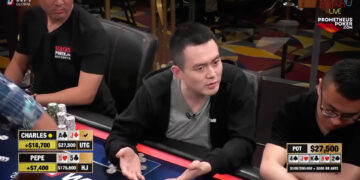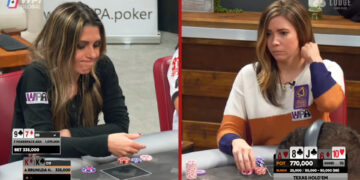Understanding Poker Bluffs
Despite those out there who would call a game like Texas Hold’em Poker a game of luck or chance, the fact is that poker requires a lot of skill to win consistently. There are quite a few skills that talented poker players have in their tool-kit, like poker bluffs. Knowing how to properly bet with the right poker hand is the difference between winning and losing.
Picking your spots and using well-timed poker bluffs opens up a slew of benefits for a poker player. Some of the benefits of a good poker bluff include but aren’t limited to:
- Controlling the action on the table
- Seizing control of the hand
- Taking down a pot with inferior cards
- Setting a precedent that makes players wary of challenging you
- Earning better value for your bets
- Laying traps and winning more money
- Enticing players into pots and winning more money
- And many more
The Art of Poker Bluffs

In any game of poker, whether it’s a single table, or one of the many popular poker tournaments in which you can join and play, players who bluff well typically do well. From pros like Doyle Brunson to Phil Hellmuth, they will all tell you that waiting around for winning cards is a surefire way to lose. If you want to win at poker, you have to assert authority, and therefore poker bluffs comes in handy.
Poker bluffs are well within the poker rules, able to be used in all poker games. However, there’s a time and a place for bluffing. You need to be able to read your opponents, have a solid poker position, tell which cards are in play, and other variables that go in to making for the right bluff.
A bluff in poker most certainly will not always pay off. Many times a bluff is called, and you lose the pot. Though if you’re able to grasp the art of the bluff, then you can be successful. Before we get into when and where to bluff, let us first go over a variety of bluffs you can make as part of your broader poker strategy.
Types of Poker Bluffs
In poker games, a bluff is often far more than pushing a bunch of chips into a pot when you don’t have anything of note in your hand. There are a wide variety of poker bluffs that you can make, depending on your position, the size of your stack, the other players at the table, and other factors. Here are a few bluff types to keep in mind.
Pure Bluff
Let’s say you’re playing Texas Hold’em poker and you reach the river but haven’t even made a pair. You stayed in the hand with a draw, for example, and now it’s busted. You don’t have anything. However, you have a nice stack of chips, so you push some in, typically at least larger than the pot size itself, if not all-in. This is called the pure bluff; this happens when you don’t have anything that’s capable of winning, though you make a play for the pot anyway.
Tip: You should only perform this type of bluff if you sense weakness in your opponent. E.g. if your opponent has checked, waiting for your action, or if the cards suggest your opponent doesn’t have a “made” hand. And you shouldn’t try this sort of bluff with multiple players in the hand, as the odds increase of someone calling this bluff and having a made hand.
Semi-Bluff
The most common type of bluff there is, the semi-bluff is when you’re betting and firing your proverbial bullets earlier in the hand with a shot to win.
Let’s say you have:
![]()
![]()
and after the flop you hit:
![]()
![]()
![]()
You don’t technically have a made hand, but you have an open-ended straight draw, with a 7 or Q, and you have a heart flush draw, and two shots to get it. A bluff here is only a semi-bluff, because you’re close to a made hand.
Tip: Keep in mind here that other players can be drawing in a situation like this too, and may call just to fish for the turn or river. Therefore semi-bluffs take a lot of courage because you may need a pony up with a big bet to chase others off the hand. It depends if you’re trying to thin the field, or chase players off the pot. So keep in mind that you’re hoping to steal to the pot, while also hoping to make your hand.
Continuation Bet
The continuation bet is one of the most effective poker bluffs in any of the many poker games because it displays strength and an unwillingness to back down. Basically, with this bet, you’re telling other players, “If you want to stay in this hand, it’ll cost you!” and thus it’s an effective way to get people to fold. So let’s say you got an A, 10 suited and raise pre-flop, but you whiff on the flop. You throw out a strong bet post-flop that reads like you tripled up or at least have a strong pocket pair.
Tip: The continuation bet bluff is the easiest for other players to read, as they know that a pre-flop raise is typically going to end with continuation. So pick your spots correctly and make sure you don’t have a family pot into which you’re bluffing. Try to target a single player and make things too risky for them to continue in the hand.
Check-Raise
The check-raise bluff is much more like a trap, and is useful in poker games of all sorts. Let’s say you had a J, Q in the hole, flop a 10, K, 4, and call someone’s bet going into the turn. The turn in an Ace, now you have a straight. You have the nuts, the best possible hand, with no suits on the board. You check again. Your opponent reads you as weak and bets. You have him on the hook, hopefully pot committed, so you raise the bet on him.
This typically works because of the pot commitment of the other player, having too much invested to fold. In this sense, the “bluff” is that you didn’t have a hand when you did.
Tip: You’re going to need a made hand on this. Yes, a check-raise on a pure bluff can really shock people, and it would be a good idea to implement a time or two. But it’s going to work most solidly if you have a made hand. The reason for this is the likelihood of the other player betting having a hand that’s good enough that he’s not going to fold on a pure bluff. The check-raise is typically to get called down to maximize winnings.
Post-Oak
With the post-oak, you’re dealing with another form of foolery. In most poker games, players with made hands will bet relatively small on the river, around the size of the pot, in hopes that people call instead of fold. The magic here is in this value-bet strategy being incredibly well established, and thus small bets on the river make people fold left and right because they don’t want to feed the stack of a player with a winner. This means the action being checked to you on the river could leave you winning the pot with a post-oak value bet.
Tip: The thing to watch out for here after the river is the check-raise. So remember to keep your bluff here to a value-bet size. If you get raised and have to come off the hand, you can simply back out with minimal losses and live to bluff another day.
When to Bluff in Poker

We want to go over a few tips here on when and where to bluff. You cannot simply muscle your way through on every hand, bluffing with reckless abandon. While it is within the poker rules, to be sure, it’s also a surefire way to lose in a hurry. The typical “donkey” player who acts this way is out before the blinds go up a level, believe that.
- Play select hands, about 15-20% of what you’re dealt, so you read to the table as a strong, cautious player. This way, you’re taken seriously when you do bluff. With this poker strategy, your bluffs are read as legit bets, and people will back off as not to lose to you.
- Limit your competition. Never bluff into a “family pot,” which is three or more players. If you’re sticking around the action to bluff, whittle the field down to heads-up if you can. There’s a reason someone’s in the hand, at least one person, if there’s a few people, and your bluff is likely to be called.
- Don’t bluff after bluffs. If you bluff on the river, for instance, and someone raises you, the worst thing you can do is return fire with an all-in bet. Sure, you might be getting bluffed, but the correct way to handle the art of the poker bluff is to seek out value in your bet. There’s no value in risking your entire stack just to bluff someone off the hand.
- Pay attention to pot odds. Let’s say it’s the turn or river, and you’re heads-up with one other player whose commitment into the pot is about 60% of his stack. There’s no way this guy can afford to fold to your bluff. Conversely, if someone’s in that hand for hardly any of their stack, they’re going to read a strong bet as far too risky for them to consider, and thus bluffs will be more successful. Bluffing is situational!
- Have strong position. Being closer to the dealer button means you’re going to finish the action in a hand, not start it. As a poker strategy, playing position works well because you get to read everyone else’s action. So if you’re going to make a semi-bluff, or check-raise or post-oak someone, having the benefit of going last means you can read their action and figure out the proper bluff amount to scare them off the hand.
There are a lot more bluffing tips and tricks you can pick up as you develop a strong poker strategy that’s particular to you and your skill-set. Playing Texas Hold’em poker in poker tournaments gives you a great opportunity to hone your skills, whether online or in real life.
Final Thoughts
Poker bluffs are perhaps the most powerful tools in your arsenal. This is because getting the right cards is all luck, but being able to read the table and control the action is all skill. If you’re able to follow along with the types of poker bluffs mentioned, and utilize the tips correctly to know where to bluff, then you should be able to include the poker bluff in your game to really increase your winnings. See you at the WSOP!
♠ pokerjournal.org
Poker Bluffs – FAQ
What is a bluff in poker?
A bluff is when you're pretending to have a strong hand with the intention of getting your opponent to fold.
How do you bluff well in poker?
You bluff well by reading your opponents and picking the right spots at the right times. You don't need to bluff big. That's a misconception.
Should you bluff in poker?
Yes. I rarely bluff big. The majority of my bluffs are smaller bets on the flop and turn, not all-ins on the river.
Can you win poker without bluffing?
It depends on the game. If it's low stakes game. yes. You could also win in a higher stakes game if you're running good, but you need to get out at the right time. Don't be greedy.


















Discussion about this post